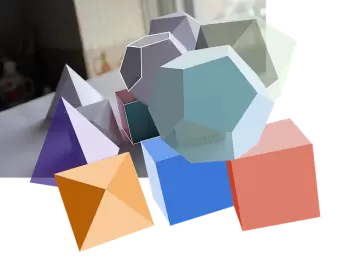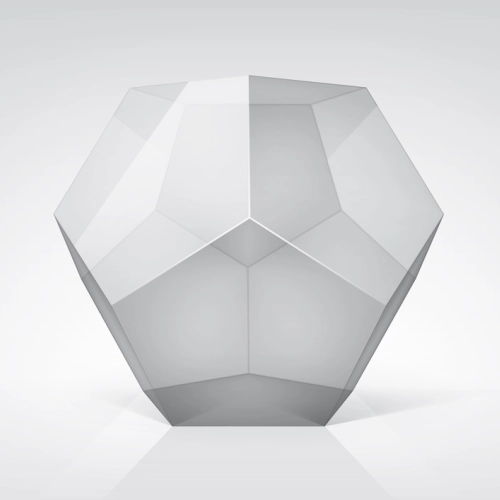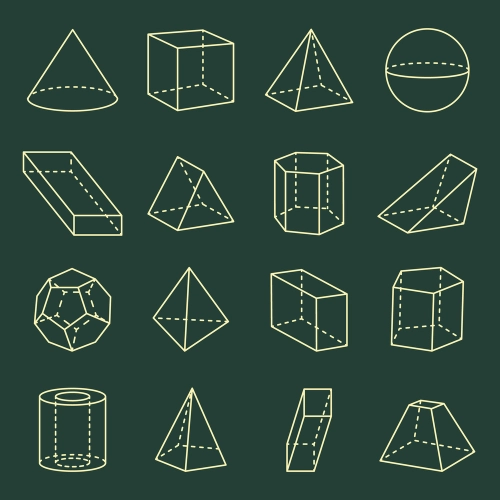
A polyhedron is a three-dimensional geometric figure whose surfaces are formed by a finite set of polygons, called faces , which enclose a defined volume.
These solids are fundamental objects in geometry, and their study has fascinated mathematicians and scientists since ancient times due to the rich variety of shapes and properties they can present.
Structure of a polyhedron
 To better understand the structure of a polyhedron, it is useful to know the relationship between the elements that make it up:
To better understand the structure of a polyhedron, it is useful to know the relationship between the elements that make it up:
- Faces : These are the flat surfaces that delimit the polyhedron. Each one is a polygon.
- Edges : These are the segments that form the edge between two adjacent faces.
- Vertices : These are the points where three or more edges meet.
In addition to these basic characteristics, polyhedra can vary considerably in terms of their symmetries and shapes. Symmetries of a polyhedron refer to spatial transformations (such as rotations or reflections) that allow the polyhedron to be mapped onto itself without altering its structure.
Classification of polyhedra
The classification of polyhedra is a key aspect in their study. Depending on their geometric characteristics, polyhedra are grouped into several categories.
1. According to convexity
-
Convex polyhedra : A polyhedron is convex if any straight line passing through it intersects its surface in only two points. In other words, all points on a straight line connecting any two points on the polyhedron will lie inside the polyhedron. A common example is the cube, where all the faces are square and each vertex forms "protruding" or convex angles.
-
Concave polyhedra : In contrast, a polyhedron is concave if any straight line can pass through its surface at more than two points. This means that the polyhedron has some "indentation" or incoming dihedral angle. Concave polyhedra can have very complex shapes, and are not as common as convex ones in nature.
2. According to the regularity of the faces
-
 Regular polyhedra : These polyhedra have exceptional symmetry. They are characterized by having all their faces formed by regular polygons (that is, polygons with equal sides and angles), and all their vertices are congruent. In regular polyhedra, the same number of faces are found at each vertex. The five regular polyhedra, known as Platonic solids , are:
Regular polyhedra : These polyhedra have exceptional symmetry. They are characterized by having all their faces formed by regular polygons (that is, polygons with equal sides and angles), and all their vertices are congruent. In regular polyhedra, the same number of faces are found at each vertex. The five regular polyhedra, known as Platonic solids , are:- Tetrahedron : Composed of four triangular faces.
- Cube (or hexahedron) : Formed by six square faces.
- Octahedron : It has eight triangular faces.
- Dodecahedron : It consists of twelve pentagonal faces.
- Icosahedron : Formed by twenty triangular faces.
These solids are unique for their high degree of symmetry and have been studied since the time of the ancient Greeks, especially by Plato, who gave them their name.
-
Irregular polyhedra : Unlike regular polyhedra, irregular polyhedra have faces and angles that are not necessarily congruent. Although they do not possess the perfect symmetry of regular polyhedra, many of them are important in architecture and engineering. Examples of irregular polyhedra include prisms and antiprisms , as well as Archimedean solids , which combine regular polygons in various configurations to form semi-regular polyhedra.
3. According to geometric uniformities
-
Uniform-faced polyhedra : All faces are identical polygons, although not necessarily regular. This type of polyhedron can have varying degrees of symmetry, but maintains the same shape on all its faces.
-
Uniform-edged polyhedra : All edges join the same pair of faces, which gives uniformity in the arrangement of the faces along the edges.
-
Uniform vertex polyhedra : In these polyhedra, all the vertices converge to the same number of faces and in the same order. That is, the arrangement of the faces around each vertex is the same throughout the polyhedron.
Historical classification and notable solids
Interest in polyhedrons is not new. Throughout history, mathematicians and philosophers have studied these shapes for their symmetry and beauty. In addition to the Platonic solids, already mentioned, other notable types of polyhedrons include:
-
Archimedean solids : These are semi-regular polyhedra that have more than one type of polygon as a face, but maintain a symmetrical arrangement at the vertices. These include the cuboctahedron and the icosidodecahedron.
-
Kepler-Poinsot solids : These stellate polyhedra are extensions of the Platonic solids, but allow intersections of the faces, giving them a more complex and exotic structure.
Geometric properties of polyhedra
There are several key formulas and theorems that help to better understand the geometric properties of polyhedra.
1. Euler's formula
One of the most fundamental properties of convex polyhedra is Euler's formula , which states that for any convex polyhedron with "V" vertices, "A" edges and "C" faces, the relationship holds:
V−A+C=2
This formula was discovered by the Swiss mathematician Leonhard Euler and is valid for all convex polyhedra.
It is an essential tool in the topology of polyhedra, since it helps us to verify the structural consistency of any polyhedron.
2. Dihedral angles
The dihedral angle is the angle formed between two adjacent faces of a polyhedron. In regular polyhedra, the dihedral angles are congruent, while in irregular polyhedra, the dihedral angles can vary. The measurement of these angles is important in determining the stability and symmetry of the polyhedron.
3. Volume and surface area
The calculation of the volume and surface area of a polyhedron depends on the geometric shapes of its faces and their spatial arrangement. In the case of regular polyhedra, there are specific formulas for calculating these quantities.
In more complex polyhedra, such as Archimedean solids, the calculation of volume and surface area requires more advanced formulas that take into account the dimensions and types of faces.
Everyday examples of polyhedrons
Polyhedrons are present in many objects of our daily life:
- Pyramids : The pyramids of Egypt are an iconic example of polyhedrons in history. They have a square base and four triangular faces.
- Cubes : Everyday objects such as boxes and dice are examples of cubes, which have six square faces.
- Soccer balls : They are made up of a combination of pentagons and hexagons, creating an approximation of a truncated icosahedron.
- Honeycombs : Bees build their honeycombs using hexagonal shapes, which are grouped into hexagonal prisms to maximize the use of space.